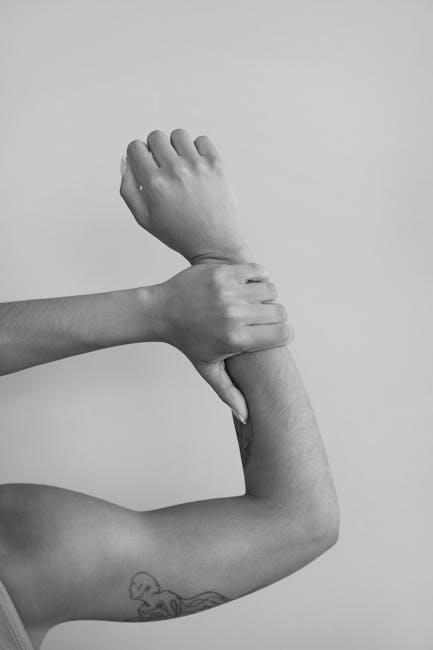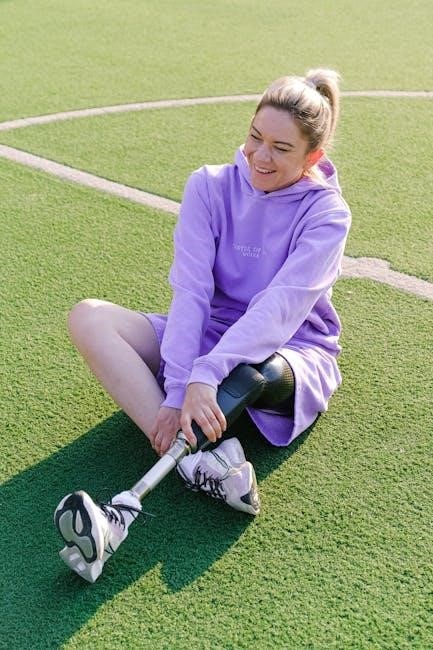Upper limb nerve glides involve specific exercises to restore nerve mobility, using
- gentle movements and stretches to improve nerve function, as seen in various online resources and pdf guides available today online.
Definition and Importance
Upper limb nerve glides refer to a set of exercises designed to improve nerve mobility and reduce symptoms associated with nerve compression or irritation. These exercises are typically used to treat conditions such as carpal tunnel syndrome, radial nerve palsy, and other nerve-related disorders. The importance of upper limb nerve glides lies in their ability to restore normal nerve function, allowing individuals to perform daily activities with ease and comfort. According to various online resources and pdf guides, upper limb nerve glides are a crucial component of rehabilitation programs for individuals with nerve damage or compression. By incorporating these exercises into their treatment plan, individuals can experience significant improvements in their overall quality of life. The definition of upper limb nerve glides is closely tied to their importance, as they provide a non-invasive and effective means of managing nerve-related disorders. With the help of upper limb nerve glides, individuals can reduce their reliance on medication and surgical interventions, instead opting for a more holistic approach to managing their condition. Overall, the importance of upper limb nerve glides cannot be overstated, as they offer a safe and effective means of restoring nerve function and improving overall health.
Purpose of Nerve Gliding Exercises
The primary purpose of nerve gliding exercises is to restore normal nerve mobility and reduce tension on the nerves, as stated in various online resources and pdf guides. These exercises aim to improve the gliding of nerves through the surrounding tissues, which can become restricted due to injury, surgery, or repetitive strain. By performing nerve gliding exercises, individuals can help to reduce nerve compression, inflammation, and scarring, ultimately leading to improved nerve function and reduced symptoms. The exercises are designed to be gentle and non-invasive, making them an ideal treatment option for individuals with nerve-related disorders. According to the available information, the purpose of nerve gliding exercises is to promote healthy nerve function, reduce pain and discomfort, and improve overall mobility and flexibility. By incorporating these exercises into their treatment plan, individuals can experience significant improvements in their condition and overall quality of life. The purpose of nerve gliding exercises is closely tied to their ability to promote nerve health and reduce symptoms.

Exercises for Upper Limb Nerve Glides
Upper limb nerve glides involve specific
- exercises to improve nerve mobility and function online;
Radial Nerve Gliding Program
A radial nerve gliding program typically involves a series of exercises designed to improve the mobility and function of the radial nerve, which runs from the neck down to the hand. The program usually starts with gentle movements and progresses to more advanced exercises. According to online resources and pdf guides, the radial nerve gliding program can be tailored to individual needs and goals. The exercises may include wrist extensions, finger spreads, and elbow movements, all of which help to reduce nerve compression and improve nerve gliding. By following a radial nerve gliding program, individuals can improve their overall upper limb function and reduce symptoms of nerve damage or compression. The program can be modified to suit different levels of ability and can be performed in various settings, including at home or in a clinical environment. Regular practice and patience are key to achieving optimal results from the program.
Shoulder and Scapular Joint Mobilization
Shoulder and scapular joint mobilization is an essential component of upper limb nerve glides, as it helps to improve the mobility and function of the shoulder and scapular joints. This can be achieved through various techniques, including gentle movements and stretches, as outlined in online resources and pdf guides. The goal of shoulder and scapular joint mobilization is to reduce stiffness and improve range of motion, which can help to alleviate symptoms of nerve compression and improve overall upper limb function. By incorporating shoulder and scapular joint mobilization into a nerve gliding program, individuals can experience improved mobility and reduced discomfort. The exercises can be modified to suit different levels of ability and can be performed in various settings, including at home or in a clinical environment. Regular practice and patience are key to achieving optimal results from shoulder and scapular joint mobilization. This can be done with the help of a healthcare professional or through self-directed exercises.

Benefits of Upper Limb Nerve Glides
Upper limb nerve glides provide numerous benefits, including improved mobility and reduced symptoms, as outlined in various online resources and pdf guides available today for upper limb nerve glides exercises.
Improving Functional Use
Upper limb nerve glides play a crucial role in improving functional use of the upper limb, as evident from various online resources and pdf guides. The exercises help to restore nerve mobility, reducing symptoms and improving overall function. By incorporating nerve glides into a rehabilitation program, individuals can experience improved range of motion, strength, and dexterity. This, in turn, enables them to perform daily activities with greater ease and independence. The benefits of nerve glides are not limited to physical function, as they also promote overall well-being and quality of life. With regular practice, individuals can improve their ability to perform tasks such as dressing, grooming, and cooking, thereby enhancing their autonomy and self-confidence. Furthermore, nerve glides can be modified to suit individual needs and abilities, making them an accessible and effective rehabilitation tool for a wide range of individuals. This versatility is a key advantage of nerve glides.
Reducing Symptoms

Upper limb nerve glides are an effective way to reduce symptoms associated with nerve damage or compression, as discussed in various online resources and pdf guides. The exercises help to alleviate pain, numbness, and tingling sensations in the affected areas. By promoting nerve mobility and reducing pressure on the nerves, nerve glides can help to decrease the frequency and severity of symptoms. This can lead to significant improvements in overall comfort and quality of life. Nerve glides can also help to reduce muscle spasms and stiffness, making it easier to move and perform daily activities. Additionally, the exercises can help to improve circulation and reduce inflammation, which can further contribute to symptom reduction. Overall, incorporating nerve glides into a rehabilitation program can be a valuable tool for managing symptoms and promoting recovery. Regular practice can help to minimize discomfort and maximize functional ability, enabling individuals to engage in activities with greater ease and confidence.
Upper limb nerve glides provide long-term benefits, improving overall mobility and function, as outlined in various online pdf guides and resources available today for easy access online always.
Getting Started with Exercises
To initiate upper limb nerve glides, individuals should begin by understanding the fundamental principles and objectives of these exercises, as outlined in various online resources and pdf guides.

The initial steps involve identifying the specific nerve or region that requires attention, and then selecting the most suitable exercises to target that area.
A thorough understanding of proper posture, movement, and technique is essential to ensure effective and safe execution of the exercises.
It is also crucial to start slowly and gradually progress to more advanced movements, allowing the nerves and surrounding tissues to adapt and respond positively.
Additionally, maintaining a consistent routine and monitoring progress can help individuals stay motivated and achieve optimal results from their upper limb nerve glides exercises.
By following these guidelines and consulting with healthcare professionals or qualified therapists, individuals can effectively get started with upper limb nerve glides and experience the benefits of improved nerve mobility and overall well-being.
